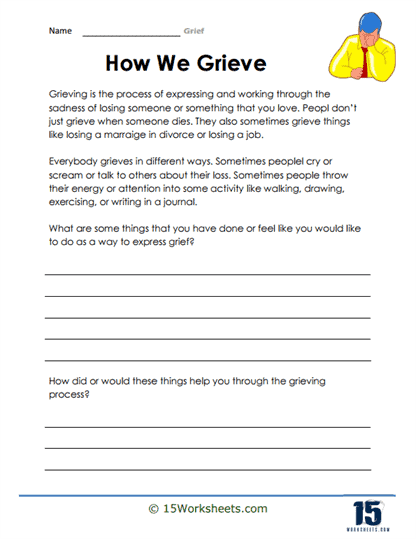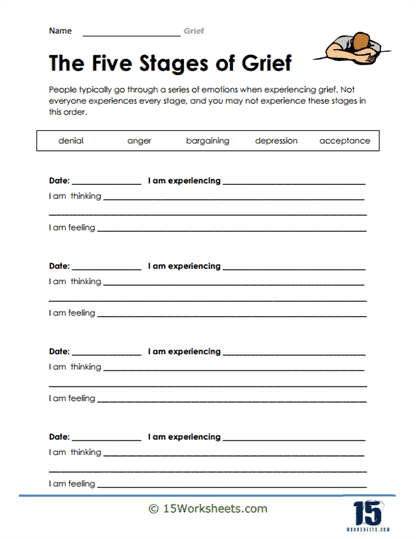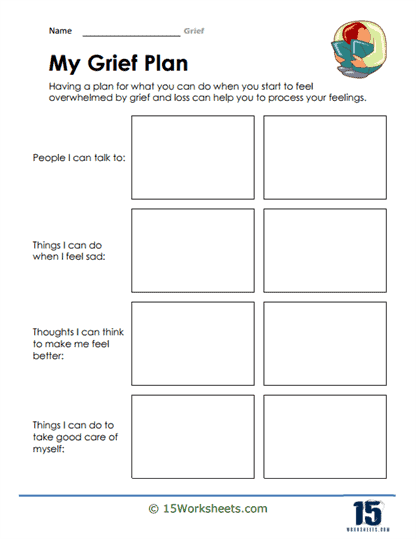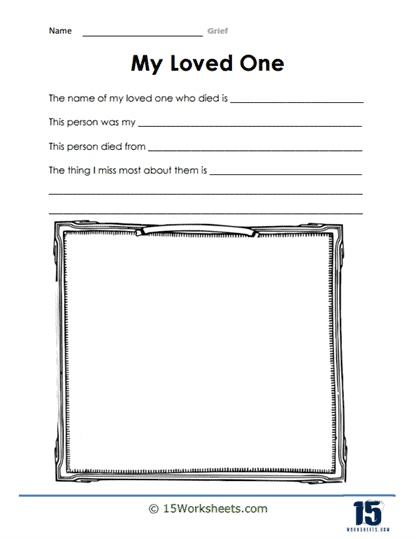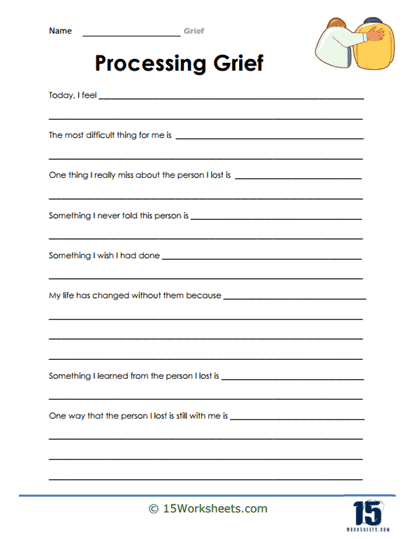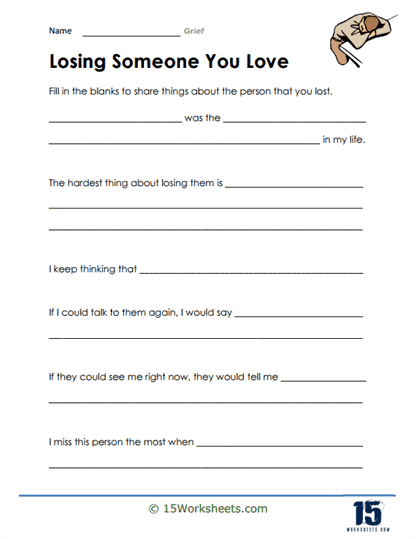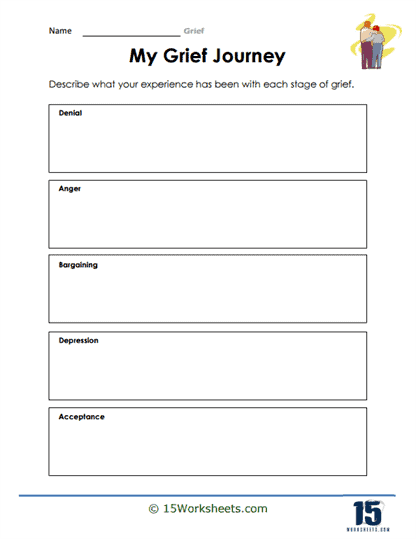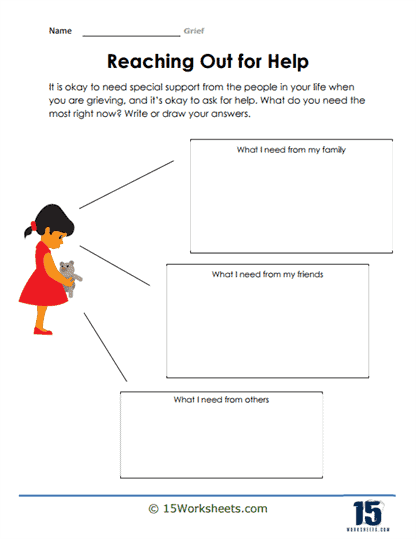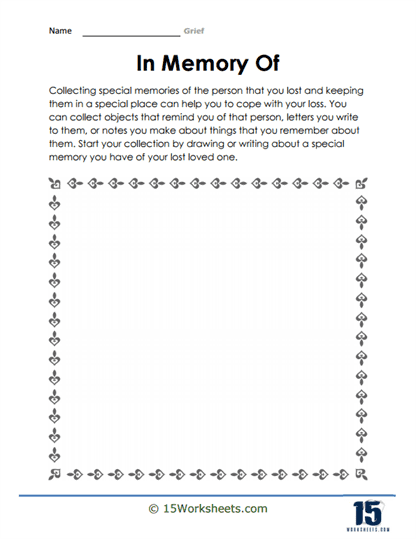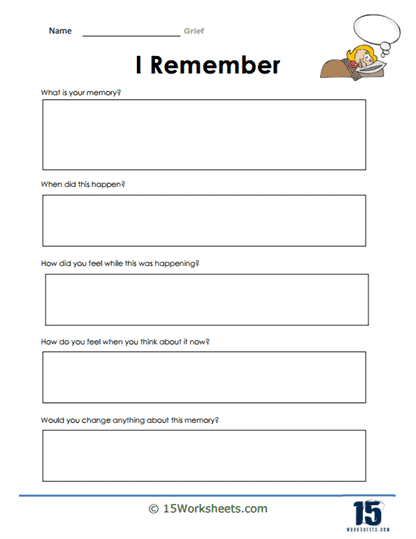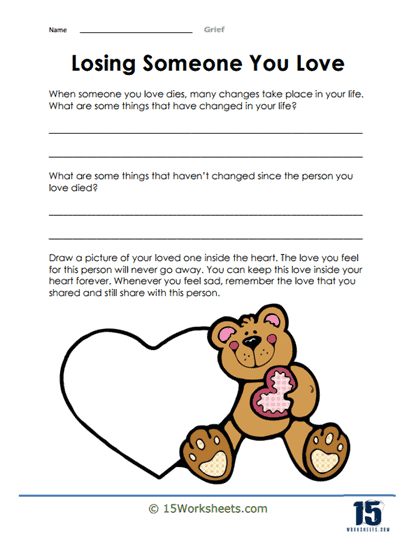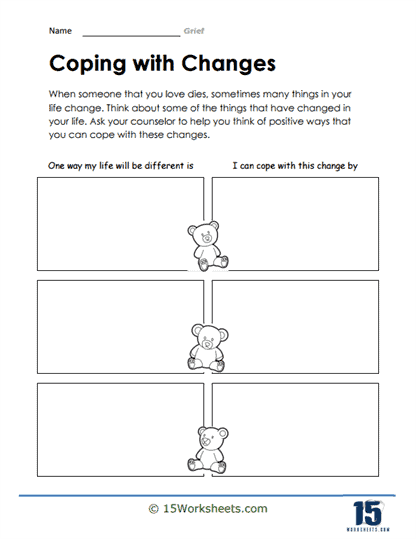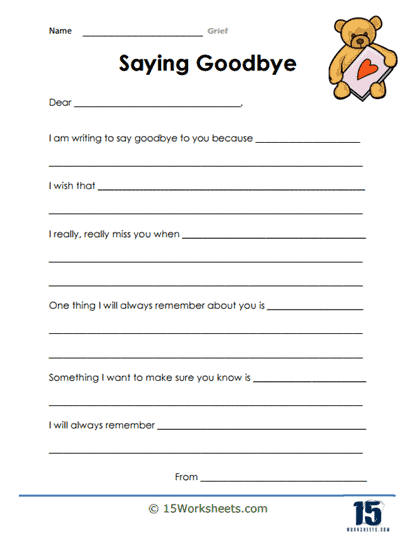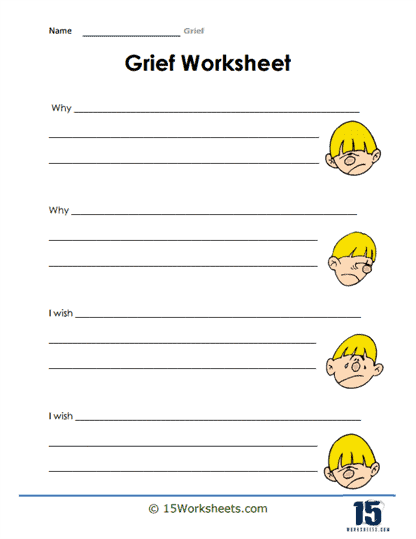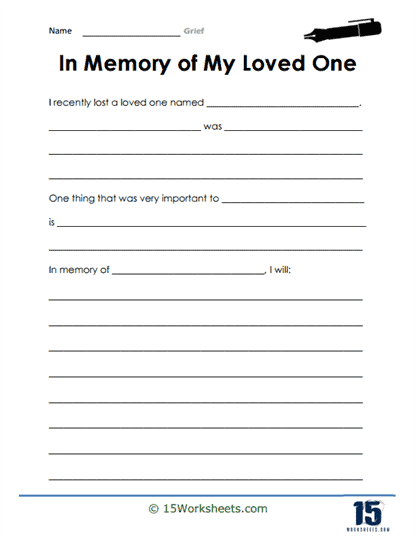Grief Worksheets
All About These 15 Worksheets
Grief is one of the most profound emotions a person can experience. It emerges in response to the loss of someone or something significant and can feel overwhelming, confusing, and deeply personal. The weight of grief is not only shaped by the magnitude of the loss but also by the individual’s unique relationship with what they’ve lost, making it an intensely subjective and multifaceted experience. Understanding this, it becomes clear that grieving is not a linear process, nor is it one-size-fits-all. It is an emotional journey, one that varies greatly from person to person. For students, especially those still learning to navigate the complexities of their emotions, the grieving process can feel especially challenging. This is where the “Grief” series of worksheets steps in-a carefully crafted set of 15 resources designed to help students understand and process their grief in a structured, compassionate, and supportive manner.
The foundation of this series is built on the recognition that grief is a natural and universal response to loss, though it manifests uniquely in each person. One of the first ideas introduced in these worksheets is that grief is not something to be feared or avoided, but rather an emotion to be understood and embraced. By framing grief as a natural and essential response to loss, the worksheets aim to reduce the stigma often associated with intense emotions. Instead of feeling isolated in their sorrow, students are encouraged to see their grief as a valid expression of love and connection to what they have lost.
Each worksheet in this series is carefully designed to guide students through different stages and facets of grief. This begins with helping students recognize and name the wide range of emotions they may experience. Grief is rarely a singular emotion; it is a tapestry of feelings, including sadness, anger, confusion, guilt, and even moments of relief. These emotions can be overwhelming if left unexamined, but by providing students with the space and tools to explore these feelings, the worksheets foster emotional awareness and self-reflection. Understanding that it’s okay to feel a multitude of emotions, sometimes even conflicting ones, helps students make sense of their experience and begin to untangle the knots of confusion that often accompany loss.
As students progress through the worksheets, they are also introduced to the concept of healthy coping strategies. Coping is essential in navigating grief, but not all coping mechanisms are helpful. Some may turn to avoidance, distraction, or unhealthy behaviors to numb the pain. The worksheets aim to shift students away from these unproductive patterns by helping them develop personal strategies that promote healing and well-being. Whether it’s journaling, engaging in creative expression, or finding solace in nature, students are encouraged to explore different methods of self-care that resonate with them. These strategies are not quick fixes but rather tools to help them face and process their grief in a constructive way.
One of the most profound exercises in the series involves creating tributes to honor the memory of what has been lost. Grief is often accompanied by a fear of forgetting or losing connection with the person or thing we have lost. By encouraging students to reflect on positive memories and create tangible tributes-whether through art, writing, or other creative outlets-the worksheets help students preserve those memories in meaningful ways. This act of remembrance is not just about looking backward; it also serves as a bridge to healing, allowing students to integrate their loss into their lives in a way that fosters a sense of continuity and hope.
An equally important aspect of the grieving process is seeking and receiving support. Grief can feel incredibly isolating, and many people struggle to reach out for help during such a vulnerable time. The worksheets provide students with the opportunity to reflect on the types of support available to them, whether from friends, family, teachers, or counselors. It emphasizes that seeking support is not a sign of weakness but a courageous step toward healing. Additionally, the worksheets encourage students to consider how they can support others in their grief, fostering a sense of community and mutual care. By understanding both sides of the support system-giving and receiving-students learn that they are not alone in their journey.
Reflective exercises are woven throughout the series, encouraging students to contemplate how their loss has shaped them. Grief, while painful, is also an experience that can lead to growth, resilience, and even a deeper understanding of life and themselves. These reflections are not about finding a “silver lining” or diminishing the significance of the loss, but about recognizing the strength that comes from enduring hardship. Through these reflective exercises, students are invited to consider how they can carry forward the lessons and memories from their loss in a way that enriches their lives and helps them navigate future challenges with greater resilience.
The goal of this worksheet series is not to rush students through their grief or provide definitive answers to complex emotional questions. Rather, it offers a compassionate framework for students to process their emotions at their own pace, with guidance and support along the way. By engaging with these worksheets, students will not only develop a deeper understanding of their grief but also acquire tools that will serve them well beyond the grieving process. They will build emotional awareness, learn to cope in healthy and constructive ways, and understand the importance of support systems. Most importantly, this series validates their emotions, fostering a sense of belonging and acceptance in what is often a very isolating experience.
Ultimately, this series empowers students to find meaning in their loss. It shows them that grief, while deeply painful, can also be a pathway to personal growth, strength, and renewed hope. By engaging with their grief in an intentional and reflective way, students are not just surviving their loss but learning to move forward with a sense of purpose. The journey through grief is never easy, but with the right support and tools, it can lead to a place of healing, resilience, and, eventually, peace.
Helping Children Deal with Grief
Most young children do not know what grief is, even if they feel it. They find it hard to explain the emotions they are experiencing, which can make the entire process highly confusing to them.
As a parent or teacher, you cannot protect a child from grief. However, you can help them deal with it and cope so they always feel safe.
It is important to remember that every child deals with loss and tragedy differently. Their defense mechanisms are still developing, making it easy for them to feel overwhelmed.
1. Allow Children to Express their Feelings
If a child has gone through some major change in their life, you must allow them to explain what they are feeling. Some children may not know the exact name of the emotion they are experiencing but will be able to vaguely tell you if they feel sad or angry.
Since most children have a hard time using words to express their emotions, you can provide them with notebooks so that they can draw their feelings. Other outlets may include telling stories, looking through photo albums together, or building a scrapbook.
2. Keep the Child’s Age in Mind
If the child has gone through a tragic event but is too young to grasp the concept of it, it is vital to understand how much you can tell him. You do not want to give out more gruesome information than you have to, especially if your child is not emotionally mature.
While older children can wrap their minds around abstract concepts, younger children tend to believe in the concept of hope. When asked a question, it is best to answer as clearly and honestly as possible. It is okay if you do not have all the answers but make sure to be available to your child so they do not feel alone or neglected.
3. Acknowledge their Feelings
When children are dealing with grief, it is highly recommended that as an adult, you acknowledge their feelings. This means telling them that what they feel is okay and there is nothing wrong with being sad. This will ensure that your child does not bottle up his feelings as he grows up but instead takes time to feel what they are feeling.
For example, if your child is sad that their pet fish died, do not say things like, “It’s just a fish, don’t be sad.” Instead, grieve with them, hold a funeral, write a letter to the fish, and help your child move on.
4. Stick to a Routine
The best way to help a child deal with grief is by building a routine they will stick to. It is important to keep your child distracted so that they can also explore other feelings. You need to help your child understand that even though they are allowed to feel grief, the world does not stop, and time goes on.
Research shows that children find comfort in routines. A routine helps bring a sense of normality and consistency back to their lives so that instead of fearing the unknown, they learn to rely on predictability.
A routine also helps children realize that they have some form of control over the world around them. This provides a buffer between the things they can change and what they cannot change. In turn, this concept helps regulate their nervous system, allowing them to pick up old activities that brought them comfort.
Grief, though a deeply personal and challenging experience, can be navigated with the right support, understanding, and tools. The “Grief” series of worksheets provides a structured yet compassionate approach, helping students process their emotions in healthy and constructive ways. By acknowledging the multifaceted nature of grief, encouraging emotional expression, and fostering coping strategies, these resources empower students to face their loss with resilience. For children, the guidance of adults is crucial, offering space for them to express their feelings and find comfort in routines. Through this support, students and children alike can learn to move forward, honoring their loss while embracing hope and healing.

